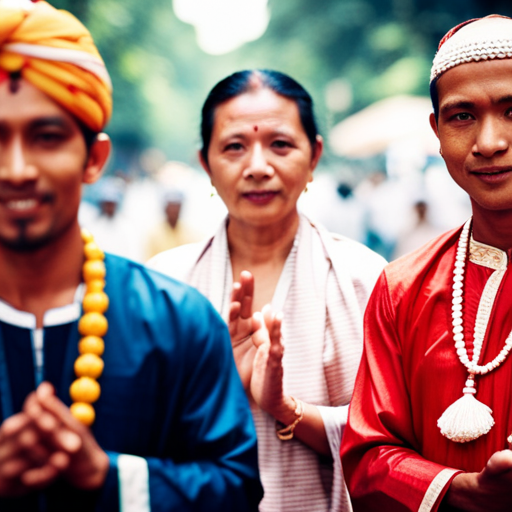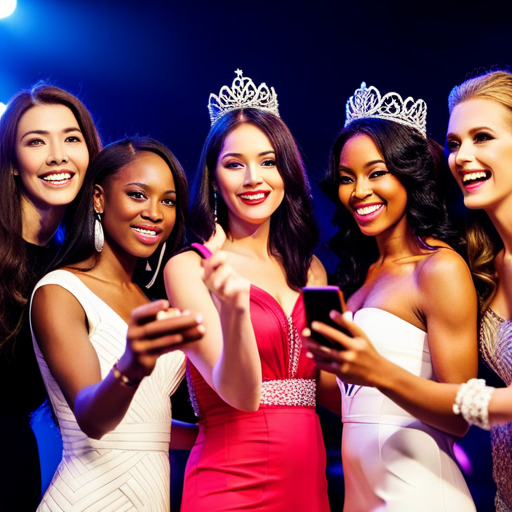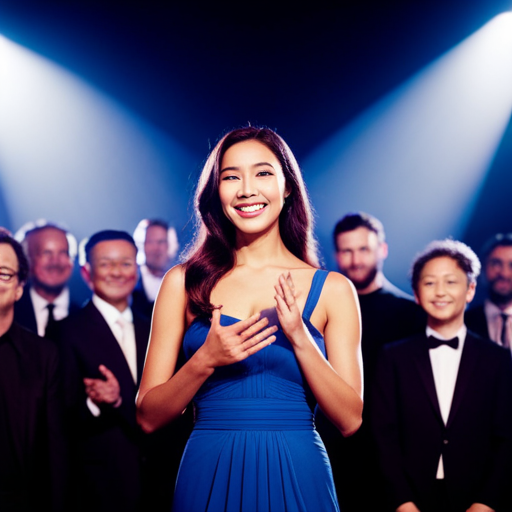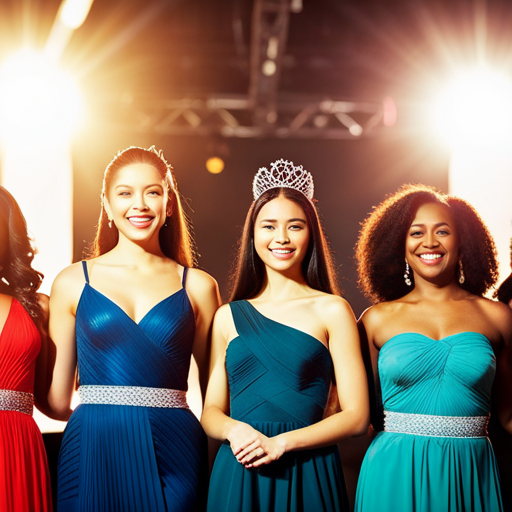Cultural Etiquette and Global Pageant Norms

Are you prepared to navigate the intricate tapestry of cultural norms and global pageant etiquette?
In the world of pageantry, understanding and respecting diverse cultural etiquettes and norms are paramount.
From dress codes to communication styles, embracing cross-cultural perspectives is essential for participants and organizers alike.
This article explores the importance of cultural etiquette and global pageant norms, offering an in-depth analysis and contextual understanding for those navigating the international pageant landscape.
Importance of Cultural Etiquette
In the context of global pageants, understanding and respecting cultural etiquette is paramount for fostering positive international relations and promoting cross-cultural understanding. Cross-cultural communication and international protocol play a crucial role in ensuring that participants, organizers, and attendees conduct themselves in a manner that is respectful and considerate of diverse cultural norms and practices.
In the realm of global pageants, where representatives from various countries come together, adhering to international protocol is essential for creating an environment of mutual respect and appreciation for different customs and traditions.
Cultural etiquette encompasses a wide range of practices, including appropriate forms of address, gestures, and dress codes, all of which vary significantly across different cultures. Failing to observe these nuances can lead to misunderstandings or inadvertently causing offense. By embracing cultural etiquette, global pageant participants can demonstrate their willingness to engage in respectful and inclusive interactions, fostering an environment where diverse perspectives are valued and celebrated.
Understanding global pageant norms requires a deep appreciation for the significance of cultural etiquette in promoting harmony and understanding among participants from different cultural backgrounds. Therefore, it is crucial to delve into the specific norms and expectations that govern global pageants, ensuring that these events serve as platforms for cultural exchange and mutual respect.
Understanding Global Pageant Norms
An integral aspect of understanding global pageant norms involves recognizing the diverse cultural expectations and practices that shape the conduct of participants and organizers. Global beauty pageants are not only about showcasing physical attractiveness but also about embodying grace, poise, and intelligence, in line with respective societal expectations. Cross-cultural awareness is crucial in comprehending the varied beauty standards and social norms that influence these events. These norms are not static but evolve with time and changing attitudes towards beauty and womanhood.
-
Diverse Beauty Standards: Different cultures have distinct ideals of beauty, which are reflected in the selection criteria for pageant contestants.
-
Societal Expectations: Pageant norms are influenced by the societal norms and values of the hosting country, impacting the conduct and expectations of participants.
-
Evolution of Norms: Understanding the historical and contemporary context of beauty pageants in different cultures is imperative for a comprehensive understanding of global pageant norms.
Dress Code and Attire Guidelines
The dress code and attire guidelines for global beauty pageants play a significant role in shaping the overall presentation and representation of contestants on the international stage. These guidelines are often influenced by cultural norms, societal expectations, and the tradition of the pageant.
Formal attire expectations vary across different global pageants, with some favoring traditional evening gowns, while others may embrace more contemporary or culturally specific formal wear. For instance, Miss Universe may have a more universal approach to formal attire, whereas Miss World might incorporate traditional elements from various cultures into the contestants’ outfits.
Understanding and adhering to these dress guidelines is crucial as it not only reflects respect for the hosting culture but also demonstrates a contestant’s ability to adapt and appreciate diverse sartorial traditions. Moreover, the attire worn by contestants can also serve as a means of cultural exchange, allowing for the celebration and sharing of different global fashion sensibilities.
Therefore, the dress code and attire guidelines in global beauty pageants carry substantial cultural significance and should be approached with thoughtful consideration and respect for diverse traditions.
Communication and Language Considerations
How do communication and language considerations impact the international representation of contestants in global beauty pageants?
Communication and language play a crucial role in the portrayal of contestants in global beauty pageants, influencing their ability to express themselves effectively and connect with diverse audiences. When considering the impact of communication and language on international representation, several key factors come into play:
-
Language barriers: Contestants from different linguistic backgrounds may encounter challenges in effectively communicating their thoughts and ideas, potentially hindering their ability to convey their true personality and perspectives.
-
Cultural sensitivity: Understanding and respecting cultural nuances in communication is essential for contestants to avoid inadvertently causing offense or misunderstanding among international audiences.
-
Interpretation and translation: The use of interpreters and translators can significantly impact the accuracy and effectiveness of contestants’ communication, as nuances and cultural references may be lost in translation.
Navigating these communication and language considerations requires a deep understanding of cross-cultural dynamics and linguistic diversity. It is essential for contestants to approach communication with cultural sensitivity and awareness to effectively represent themselves on the global stage.
This understanding sets the stage for the subsequent section about ‘respect for traditions and customs’, as it further highlights the importance of cultural awareness in global beauty pageants.
Respect for Traditions and Customs
Navigating the impact of communication and language considerations on international representation, contestants in global beauty pageants must uphold respect for traditions and customs.
In the context of beauty pageants, respect for traditional customs and global traditions is paramount. It entails embracing the rich tapestry of diverse cultural practices and demonstrating a deep understanding and appreciation for the customs of different countries and regions.
Contestants are expected to display sensitivity and awareness of traditional customs, such as attire, gestures, and greetings, when representing their own culture and when interacting with others from around the world. This involves a nuanced understanding of the historical and cultural significance of various traditions, as well as the ability to navigate the complexities of cross-cultural interactions with grace and respect.
Moreover, demonstrating respect for global traditions involves acknowledging the diversity of customs and practices, and the significance they hold for different communities. It is crucial for contestants to approach these traditions with humility, curiosity, and a willingness to learn, thereby fostering mutual respect and understanding on the international stage.
Etiquette During Pageant Performances
When it comes to pageant performances, stage presence is a crucial aspect that varies across different cultures. Understanding the nuances of cultural dance and respecting the sensitivities associated with it is essential for a successful and culturally sensitive performance.
Additionally, nonverbal communication plays a significant role in conveying respect and understanding, making it important to be mindful of cross-cultural differences in this regard.
Stage Presence Dos
Performing on stage during a pageant requires contestants to exude confidence, poise, and grace while captivating the audience and judges. To enhance their stage presence, contestants should focus on body language tips and confidence enhancement techniques.
Here are some dos for contestants to consider:
- Maintain strong posture: Stand tall with shoulders back to convey confidence and poise.
- Make eye contact: Engage with the audience and judges by making meaningful eye contact to establish a connection.
- Smile genuinely: A warm and genuine smile can exude positivity and charm, creating a lasting impression.
Cultural Dance Sensitivities
Building on the previous subtopic of Stage Presence Dos, it is essential to consider cultural dance sensitivities and etiquette during pageant performances to ensure respect and understanding across diverse audiences and judges.
Cultural dance holds significant meaning and symbolism in various societies, making it crucial for pageant contestants to approach these performances with sensitivity and awareness. Understanding the historical and cultural context of the dance being performed is imperative to avoid inadvertently causing offense.
It is vital to research and comprehend the traditional attire, gestures, and movements associated with the dance to ensure an authentic and respectful portrayal. Additionally, contestants should be mindful of any religious or spiritual significance attached to the dance and act accordingly.
Nonverbal Communication Nuances
During pageant performances, it is essential for contestants to convey nonverbal communication nuances with grace and precision. Body language and nonverbal cues play a significant role in conveying confidence, poise, and cultural awareness on stage. Understanding cross-cultural signals and international gestures is crucial for ensuring that nonverbal communication resonates positively with diverse audiences. Contestants should be mindful of their gestures, facial expressions, and posture, as these elements can convey different meanings across cultures.
It is important for contestants to exhibit respectful and inclusive nonverbal communication, reflecting an understanding of the diversity present in the pageant audience and the global community. Mastering nonverbal communication nuances enables contestants to connect with the audience on a deeper level, transcending linguistic barriers and fostering an inclusive environment.
Moving forward, let’s delve into the significance of diversity and inclusion in pageantry.
Diversity and Inclusion in Pageantry
As the world becomes increasingly interconnected, it is imperative that pageantry embraces diversity and inclusion in all its forms.
Inclusivity challenges and representation barriers are significant issues that need to be addressed within the pageantry world. Historically, pageants have often been criticized for their lack of diversity in terms of race, body type, and gender representation. This has created a barrier for individuals from various cultural and ethnic backgrounds to participate in pageantry.
To promote inclusivity, pageants need to actively seek out contestants from diverse backgrounds and provide them with equal opportunities to showcase their talents and beauty on a global platform. Moreover, it is essential for pageants to celebrate and embrace the unique cultural heritages and traditions of all participants, fostering an environment of respect and appreciation for diversity.
By addressing inclusivity challenges and representation barriers, pageants can become more inclusive and representative of the diverse global population they aim to engage with.
This sets the stage for the subsequent section, which delves into the importance of adapting to different judging criteria.
Adapting to Different Judging Criteria
Utilizing an objective and standardized judging criteria is crucial for ensuring fairness and impartiality in international pageants. However, adapting to different judging standards across various cultures and regions is a significant challenge for contestants and organizers.
To effectively navigate this challenge, it is essential to consider the following:
-
Cultural Sensitivity: Understanding the cultural nuances and preferences of the judging panel in different regions is vital. This requires thorough research and cross-cultural sensitivity to ensure that contestants can align their presentations with the specific expectations of the judges.
-
Flexibility and Adaptation: Contestants need to be adaptable and open-minded when it comes to adjusting their performances based on the diverse judging criteria they may encounter. This flexibility demonstrates respect for the host culture and its unique pageantry norms.
-
Transparency and Education: Organizers should prioritize transparency in communicating the judging criteria to contestants. Additionally, providing educational resources on cross-cultural adaptation can empower participants to navigate diverse judging standards effectively.
Successfully adapting to different judging criteria in international pageants requires a deep understanding of cross-cultural dynamics and a willingness to embrace diverse standards while maintaining authenticity and integrity.
Frequently Asked Questions
How Do Pageants Impact Cultural Perceptions and Stereotypes?
Pageants impact cultural perceptions and stereotypes by showcasing diverse representations of beauty, talent, and traditions. They contribute to global inclusion and challenge narrow perceptions. Understanding their influence requires in-depth analysis and cross-cultural perspective.
What Are Some Common Misconceptions About Cultural Etiquette in Pageantry?
What are some common misconceptions about cultural etiquette in pageantry? Misunderstandings often arise due to generalizations about etiquette guidelines, overlooking diverse cultural norms. Understanding global beauty standards requires a nuanced, cross-cultural perspective.
How Do Pageant Organizers Ensure Diversity and Inclusion in Their Events?
Pageant organizers ensure inclusivity and representation by actively seeking diverse contestants from different backgrounds. They promote cultural exchange by showcasing traditional customs and values, fostering a platform for global understanding and appreciation.
Are There Any Specific Traditions or Customs That Contestants Should Be Mindful of During International Pageants?
When participating in international pageants, contestants should prioritize cultural sensitivity and adhere to international protocol. Understanding and respecting diverse traditions and customs is crucial for fostering an inclusive and respectful pageant environment.
How Do Judges From Different Cultural Backgrounds Approach and Evaluate Pageant Performances?
Cross-cultural judging entails diverse perspectives and values, impacting performance evaluation. Cultural norms and stereotypes influence judges’ perceptions. Contestants’ awareness, inclusion strategies, and understanding international customs are vital for navigating varied cultural backgrounds in pageant evaluations.
Conclusion
In conclusion, the adherence to cultural etiquette and global pageant norms is paramount in the realm of pageantry.
It is imperative to understand and respect the diverse traditions, customs, and dress codes of different cultures.
Effective communication and language considerations, as well as embracing diversity and inclusion, are essential for successful participation in international pageants.
Adapting to various judging criteria and showcasing respect for global traditions are key components for excelling in the global pageant arena.





